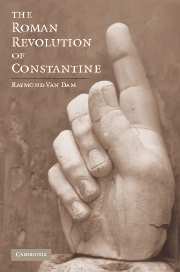Book contents
- Frontmatter
- Contents
- PREFACE
- ABBREVIATIONS
- Map
- Introduction: AUGUSTUS AND CONSTANTINE
- SECTION I A ROMAN EMPIRE WITHOUT ROME
- SECTION II A GREEK ROMAN EMPIRE
- SECTION III EMPEROR AND GOD
- 9 “BEGOTTEN OF THE GODS”: THE IMPERIAL TETRARCHY
- 10 “BEGOTTEN FROM THE FATHER”: THE CHRISTIAN TRINITY
- 11 “ONLY-BEGOTTEN SON”: HISTORY BECOMES THEOLOGY
- 12 THE SEARCH FOR THE CHRISTIAN DOCTRINE OF THE EMPEROR
- Epilogue: ONE EMPEROR
- APPENDIX 1 HISPELLUM: DATE, TEXT, AND TRANSLATION
- APPENDIX 2 ORCISTUS: DATES, TEXT, AND TRANSLATION
- EDITIONS AND TRANSLATIONS
- BIBLIOGRAPHY
- INDEX
12 - THE SEARCH FOR THE CHRISTIAN DOCTRINE OF THE EMPEROR
Published online by Cambridge University Press: 05 June 2012
- Frontmatter
- Contents
- PREFACE
- ABBREVIATIONS
- Map
- Introduction: AUGUSTUS AND CONSTANTINE
- SECTION I A ROMAN EMPIRE WITHOUT ROME
- SECTION II A GREEK ROMAN EMPIRE
- SECTION III EMPEROR AND GOD
- 9 “BEGOTTEN OF THE GODS”: THE IMPERIAL TETRARCHY
- 10 “BEGOTTEN FROM THE FATHER”: THE CHRISTIAN TRINITY
- 11 “ONLY-BEGOTTEN SON”: HISTORY BECOMES THEOLOGY
- 12 THE SEARCH FOR THE CHRISTIAN DOCTRINE OF THE EMPEROR
- Epilogue: ONE EMPEROR
- APPENDIX 1 HISPELLUM: DATE, TEXT, AND TRANSLATION
- APPENDIX 2 ORCISTUS: DATES, TEXT, AND TRANSLATION
- EDITIONS AND TRANSLATIONS
- BIBLIOGRAPHY
- INDEX
Summary
After his execution john the baptist had been buried, according to legend, in Sebaste (formerly Samaria), on the west bank of the Jordan River. During the reign of Julian opponents of Christianity desecrated his tomb and scattered his bones. According to the historian Rufinus, monks from Jerusalem were able to collect John's venerable relics and bring them back to their monastery. They then sent the relics for safekeeping to Athanasius, the bishop of Alexandria. According to the historian Sozomen, monks from Jerusalem who had migrated to Cilicia eventually found John's head. The emperor Valens ordered it to be brought to Constantinople, but it was moved only as far as a village near Chalcedon. Toward the end of his reign the emperor Theodosius visited this village and took the head to Constantinople. By then John the Baptist was being hailed as a revered founder of monasticism and the ascetic lifestyle. Now a disheveled prophet who had once lived on locusts and wild honey in the wilderness was honored in a new church at the eastern capital.
Eusebius had concluded the final edition of his Ecclesiastical History with Constantine's victory over his last imperial rival. Once it became apparent in subsequent years that Christianity would continue to enjoy imperial support, much of his history of the early church had to be reconsidered. That reevaluation included the significance of Constantine. Eusebius himself, in his Life of the emperor and his panegyrics, acknowledged the need for reassessment by essentially equating Constantine with Jesus Christ.
- Type
- Chapter
- Information
- The Roman Revolution of Constantine , pp. 317 - 353Publisher: Cambridge University PressPrint publication year: 2007

